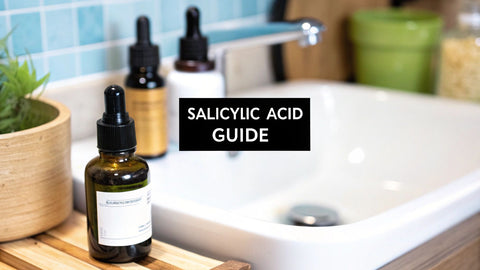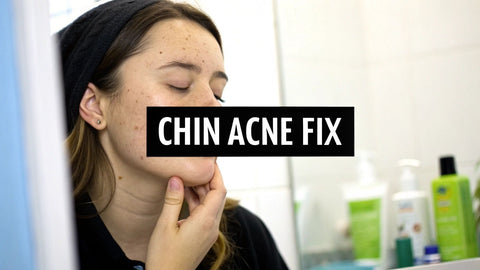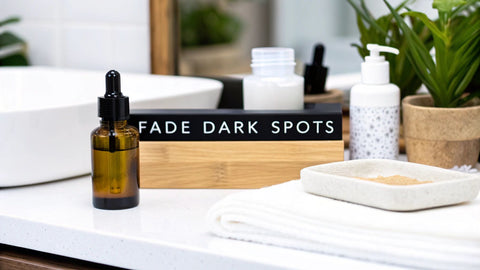Using Glycolic Acid and Benzoyl Peroxide Together

So, you're looking at your bottle of glycolic acid and your tube of benzoyl peroxide, wondering if they can be friends. The answer is a definite yes, but they need a carefully managed friendship. At Neutralyze, we specialize in perfecting this very combination, creating powerful, science-backed formulas that deliver clear skin without the guesswork.
Think of them as two key players on your acne-fighting team. One is the expert exfoliator, clearing the field of debris that clogs pores. The other is the targeted specialist, going after the bacteria that causes breakouts in the first place. Use them the wrong way, and you're in for a world of irritation. But when formulated correctly, like in the Neutralyze system? You're on your way to seriously clear skin.
Your Path to Clearer Skin Starts Here
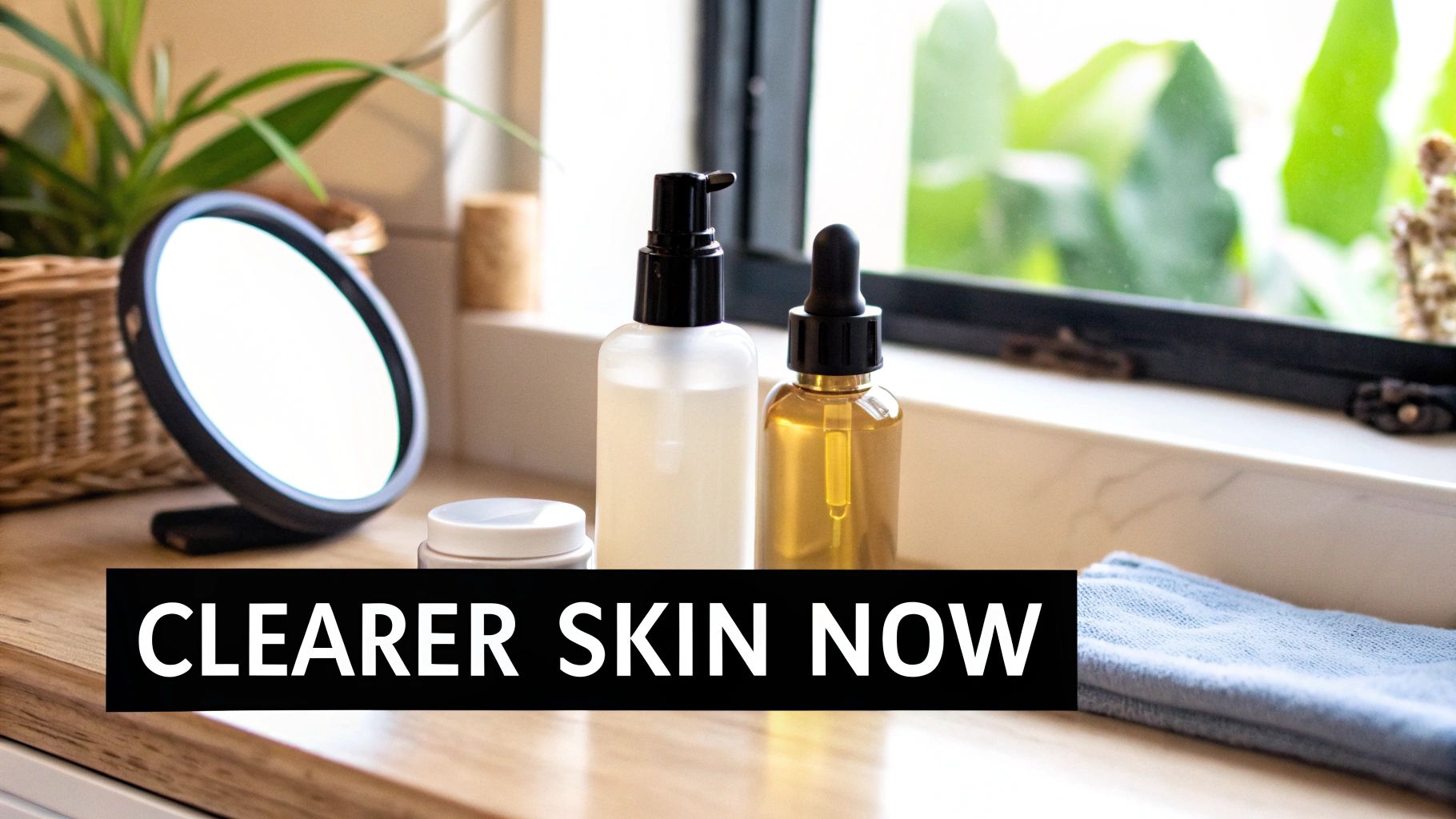
Let's be real—navigating active skincare ingredients can feel like a chemistry class you didn't sign up for. With so many potent options out there, it's totally normal to wonder what you can and can't mix. Glycolic acid and benzoyl peroxide are two of the heavy hitters in the over-the-counter acne world, but they work in completely different ways. This guide will be your roadmap to using both of them together, safely and effectively.
Understanding the Dual-Action Approach
Combining these two ingredients isn't just about throwing more at the problem; it's about building a smarter, more complete strategy against acne. Instead of relying on one ingredient to do all the heavy lifting, you're attacking breakouts from two different angles. This multi-pronged approach is often the secret to getting real, lasting results.
Here’s a breakdown of what this powerhouse combination really does for your skin:
- Unclogs Pores: Glycolic acid works on the surface, dissolving the "glue" that holds dead skin cells together. This stops them from building up and creating blockages that turn into pimples.
- Kills Acne Bacteria: Benzoyl peroxide gets down deeper into the pore and eliminates the C. acnes bacteria—the main culprit behind those red, angry, and inflamed blemishes.
- Smooths Rough Texture: By speeding up cell turnover, glycolic acid helps smooth out the bumpy, uneven texture that old breakouts can leave behind.
- Fades Post-Acne Marks: That same exfoliating power also helps lighten the stubborn red and brown spots that stick around long after a pimple is gone.
Why a Strategic Routine Matters
Just piling both ingredients onto your face at the same time is a surefire recipe for a compromised, angry skin barrier. We're talking redness, peeling, and sensitivity. The whole game is about balance—creating a routine that lets each ingredient do its job without overwhelming your skin. This is where smart formulation really shines.
At Neutralyze, our entire system is built on this very principle. We combine powerful, science-backed ingredients like these in a way that gets you the best results with the least irritation. We take all the guesswork out of building a routine that actually works.
Throughout this guide, we’ll walk you through exactly how to build a routine that not only fights current breakouts but also fades old marks and reveals smoother, clearer skin. Once you understand how to use glycolic acid and benzoyl peroxide correctly, you'll unlock a whole new level of control over your skin.
Meet Your Acne-Fighting Dream Team
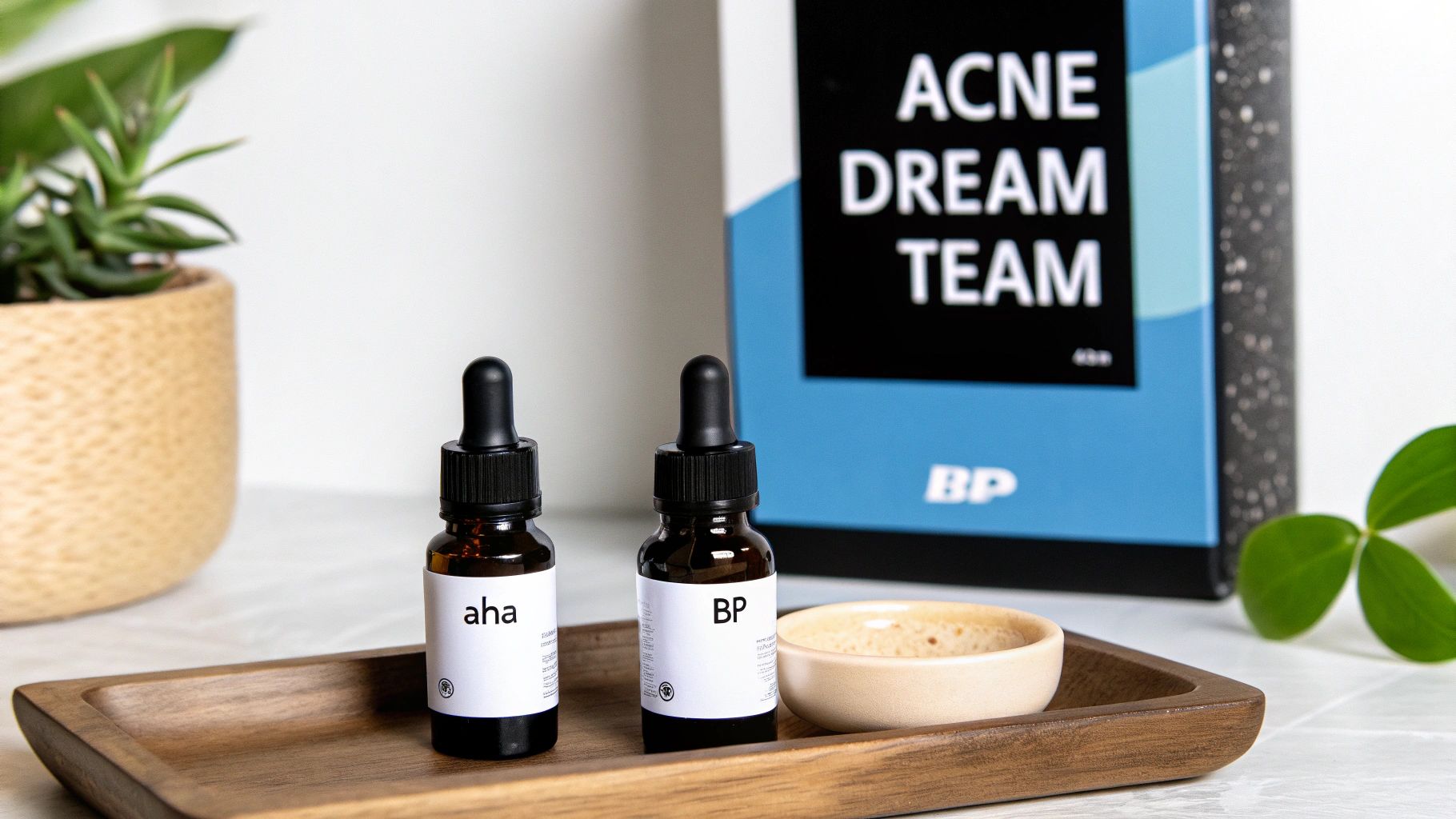
To really get why glycolic acid and benzoyl peroxide are such a powerful duo, you have to understand what each one brings to the table. Think of them as specialists on a team, each with a unique job. Once you see what they do on their own, it’s easy to see why they’re so much better together.
Let’s start with a simple analogy. Picture your skin’s surface like a cobblestone street. Over time, debris—in this case, dead skin cells—builds up, clogging the pathways and creating traffic jams in your pores. That's where our first specialist steps in.
Glycolic Acid: The Expert Exfoliator
Glycolic acid, an alpha-hydroxy acid (AHA), is like a super-efficient street sweeper for your skin. Its main purpose is exfoliation. Because of its incredibly small molecular size, it can easily get to work dissolving the "glue" that binds dead cells to your skin’s surface.
By sweeping away all that buildup, glycolic acid tackles a few key problems at once:
- Keeps Pores Clear: It stops dead skin cells from piling up and forming the plugs that turn into blackheads and whiteheads.
- Reveals Brighter Skin: By removing that dull top layer, it uncovers the fresh, glowing skin waiting just beneath.
- Smooths Everything Out: Regular use helps soften rough patches, giving your skin a much smoother, more even texture.
Essentially, glycolic acid clears the way, stopping breakouts before they even start and prepping your skin perfectly for the next step.
Benzoyl Peroxide: The Bacteria-Busting Bouncer
Now, if glycolic acid is the street sweeper, think of benzoyl peroxide as the bouncer at the door of your pores. It’s not concerned with surface-level tidying; it dives deep to handle the main troublemaker behind red, angry pimples: bacteria.
Its primary target is Cutibacterium acnes (C. acnes), the specific bacteria that turns a simple clog into an inflamed, painful breakout. Benzoyl peroxide works by releasing oxygen into the pore, which creates an environment where this anaerobic bacteria simply can’t survive. It’s a targeted strike against active breakouts, making it one of the most trusted acne-fighters out there.
You don’t have to take our word for it—the numbers speak for themselves. The global benzoyl peroxide market was valued at around $0.914 billion and is expected to climb to nearly $1.37 billion by 2032. This isn't just a trend; it's a testament to its proven effectiveness in both over-the-counter and prescription acne treatments.
Glycolic Acid vs Benzoyl Peroxide At a Glance
To make it even clearer, here’s a quick side-by-side look at what each ingredient does best.
| Feature | Glycolic Acid | Benzoyl Peroxide |
|---|---|---|
| Primary Function | Chemical Exfoliation | Antibacterial Agent |
| Target Concern | Clogged pores, dullness, uneven texture | Inflammatory acne (pustules, papules) |
| Mechanism | Dissolves bonds between dead skin cells on surface | Releases oxygen to kill acne-causing bacteria deep in the pore |
This table really highlights their complementary roles. One clears the path while the other eliminates the underlying threat.
A Perfect Partnership
When you strategically combine these two in your routine, you’re launching a comprehensive, two-front attack on acne. Glycolic acid keeps the surface clear and prevents new clogs from forming, while benzoyl peroxide gets rid of the bacteria that’s causing the inflammation you can see and feel.
This synergistic approach is the foundation of Neutralyze. We expertly formulate our products to deliver these distinct benefits, creating a system where each ingredient can do its job perfectly without causing extra irritation. It's all about giving your skin the complete care it needs to finally get clear and stay that way.
The Science of Combining These Powerhouses
When you bring glycolic acid and benzoyl peroxide into the same routine, you're not just throwing two good ingredients at a problem. You're creating a powerful synergy, where the two work together to produce results that neither could achieve on its own. It's a strategic, two-pronged attack that Neutralyze has perfected to get your skin clear and healthy.
The secret is all about how one ingredient perfectly sets the stage for the other. Think of glycolic acid as the advance team, clearing the path for the main force. Its main job is exfoliation, but that simple action has a game-changing side effect.
By dissolving the "glue" that holds dead skin cells together, glycolic acid sweeps away the top layer of buildup. This is absolutely critical because it opens up a direct path for benzoyl peroxide to get where it needs to go, penetrating deeper into your pores without anything blocking it.
Paving the Way for Deeper Action
Imagine trying to deep-clean a stained rug without vacuuming it first. You'd be fighting through a layer of surface-level dust and debris, and your cleaner wouldn't work nearly as well.
In this scenario, glycolic acid is the vacuum. It gets rid of the surface junk—the dead skin cells—so the deep cleaner, benzoyl peroxide, can hit the source of the problem.
This priming action means the benzoyl peroxide isn't just sitting on the surface; it's delivered straight to the follicles where acne-causing bacteria are having a party. The result is a much more efficient and targeted assault on the root cause of those painful, inflammatory breakouts.
This strategic partnership is the core philosophy behind a well-designed acne treatment system. By ensuring each ingredient can perform its job without obstruction, you maximize results while minimizing the potential for unnecessary surface irritation. This is the science that Neutralyze is built upon.
And this teamwork goes beyond just clearing up active pimples. The exfoliation boost from glycolic acid also helps speed up the fading of those stubborn post-acne marks and smooths out the rough texture breakouts often leave behind.
The Risk of Irritation and How to Manage It
Of course, using two potent ingredients like glycolic acid and benzoyl peroxide together comes with a major warning label: the potential for irritation. This is the number one reason people get nervous about combining them. If you just pile them on without a plan, you can end up with redness, flaky dryness, and a seriously unhappy skin barrier.
The good news is that this risk is completely manageable with a smart approach. The key isn't to avoid the combination but to use it intelligently. It all comes down to proper application, timing, and giving your skin the support it needs.
- Never layer them at the exact same time. Applying one right after the other is asking for trouble.
- Split them up. A great strategy is to use one in the morning and the other at night, or simply use them on alternate days.
- Support your skin barrier. Always, always follow up with a good, non-comedogenic moisturizer and wear a broad-spectrum sunscreen every single day.
This thoughtful, balanced approach is exactly how Neutralyze builds its skincare systems. We bake in the synergy of powerful ingredients while providing the necessary hydrating and calming elements to keep your skin healthy and receptive to treatment, making it the best solution for your skin.
The trust in glycolic acid isn't just anecdotal. The market reflects its value, with one analysis estimating the global glycolic acid market at $468.2 million and projecting it to reach $820.3 million by 2027. This boom is driven by a growing public awareness of its incredible exfoliating and skin-renewing benefits. You can discover more insights about the glycolic acid market and its continued growth.
Once you understand the science of how these ingredients cooperate, you can move past the fear of irritation and confidently put their combined power to work. It’s not about using more stuff on your face, but about using the right ingredients in the right way to achieve clear skin that lasts.
How to Safely Layer Glycolic Acid and Benzoyl Peroxide
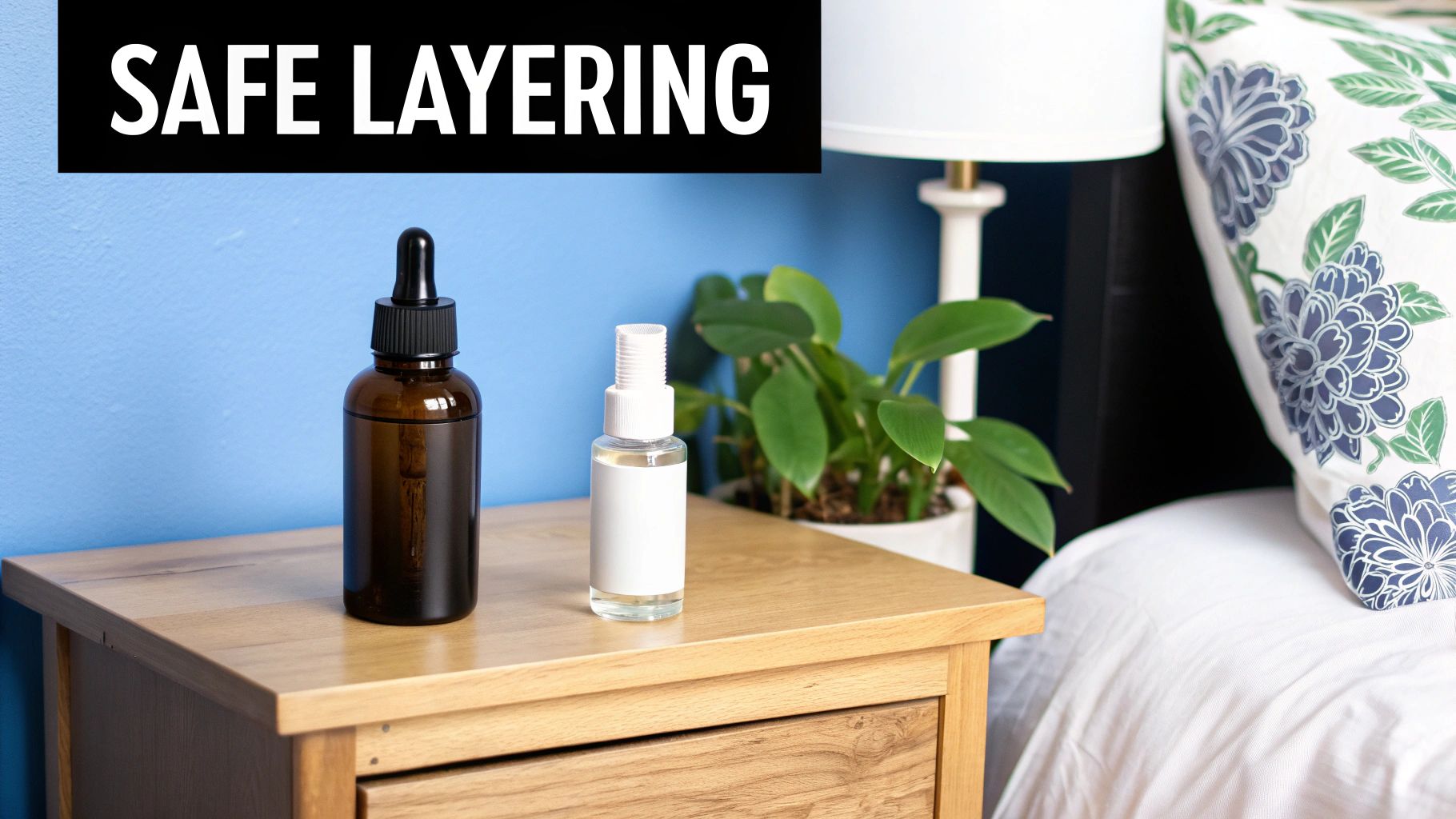
So, you're ready to combine the power of glycolic acid and benzoyl peroxide. That's great! But before you dive in, we need to talk strategy. Using two potent ingredients isn't a free-for-all; it requires a smart approach to keep your skin happy and avoid a whole lot of irritation.
In fact, there’s one golden rule you absolutely cannot break: never apply glycolic acid and benzoyl peroxide at the exact same time. Slathering them on one after the other is a recipe for redness and sensitivity, and it can even make both ingredients less effective. Think of it like this: you wouldn't do two intense, back-to-back workouts on the same muscle group. Your skin needs time to process each active ingredient on its own.
Luckily, there are two tried-and-true, derm-approved methods for getting the best of both worlds. This is where you get to customize things based on your skin's unique needs and your daily life.
Method 1: The AM/PM Split
The most common and effective strategy is to split these ingredients between your morning and evening routines. It's a simple way to give each active its own time to shine without them clashing.
Here’s what that looks like in practice:
- Morning Routine (AM): Start your day with a benzoyl peroxide cleanser, like the one found in our Neutralyze kits. This tackles acne-causing bacteria right away and keeps working throughout the day. Follow it up with your moisturizer and—this is non-negotiable—a broad-spectrum sunscreen with at least SPF 30.
- Evening Routine (PM): At night, after cleansing, it's glycolic acid’s turn. Using a toner or serum lets the AHA work its magic overnight to exfoliate, smooth out texture, and brighten your complexion while your skin is in its natural repair mode.
This approach gives you a consistent daily dose of both ingredients, making it a fantastic game plan for anyone dealing with persistent acne.
Method 2: The Alternate-Day Approach
If your skin is on the sensitive side or you're just introducing these actives, "Day Splitting" is your best friend. Instead of using both every single day, you simply alternate them on different nights.
This gives your skin a full 24 hours to recover between applications, which dramatically lowers the risk of irritation and over-exfoliation.
Expert Tip: Your skin is your best guide. If you start seeing signs of distress—like lingering redness, peeling, or a tight, stripped feeling—it's telling you to pull back. Reducing the frequency is always the smartest move.
A sample alternate-day schedule is as easy as it sounds:
- Night 1 (Monday): Use your glycolic acid product.
- Night 2 (Tuesday): Use your benzoyl peroxide product.
- Night 3 (Wednesday): You can go back to glycolic acid or give your skin a "rest day" with just a simple hydrating serum and moisturizer.
This method is incredibly flexible, allowing you to build a sustainable long-term routine that your skin can actually handle.
A Beginner-Friendly Trick: Contact Therapy
Feeling a little hesitant about leaving benzoyl peroxide on your skin? There’s an even gentler way to start called contact therapy. It's perfect for easily reactive skin types and allows you to get the bacteria-fighting benefits without the commitment.
The technique is brilliantly simple. Just apply a benzoyl peroxide cleanser, like the fantastic options from Neutralyze, and let it sit for just a few minutes—anywhere from one to five minutes is plenty. Then, rinse it off completely.
That short window of contact is enough time for the ingredient to penetrate your pores and get to work, but it dramatically cuts down on the potential for dryness and irritation. This makes it the ideal starting point for working benzoyl peroxide into a routine that already includes glycolic acid. You can begin with contact therapy and, as your skin builds tolerance, you can choose to leave it on for longer or stick with what works. It's all about that smart, measured approach to getting clear skin without wrecking your skin barrier.
Building Your Complete Skincare Routine
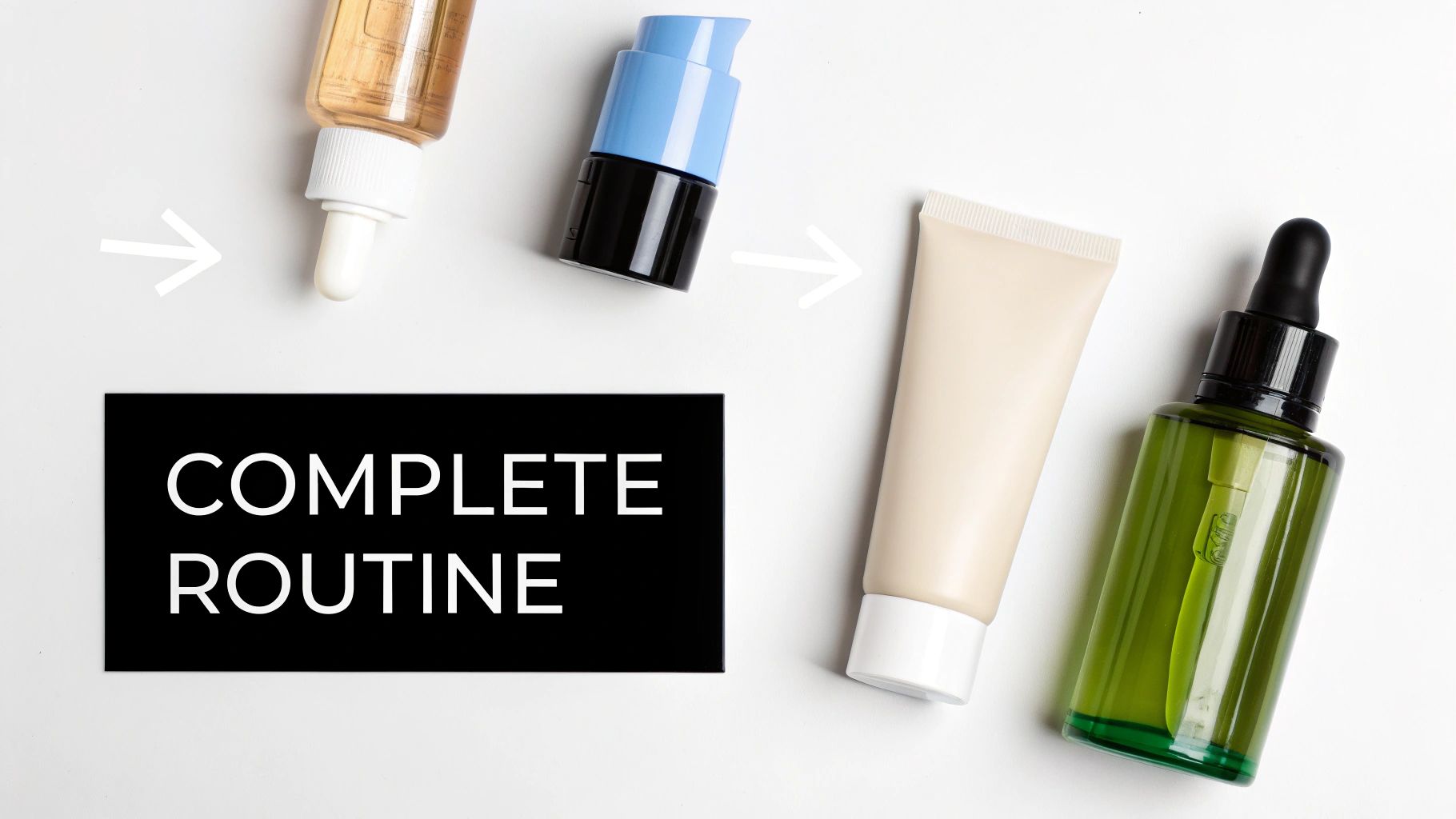
Let's be real: powerhouse ingredients like glycolic acid and benzoyl peroxide are only part of the story. To get that clear, healthy skin you're after—without ending up in a constant state of irritation—you need a solid supporting cast. Think of your routine as a team. Your actives are the star players, but they can't win the game alone.
A truly effective routine does more than just blast away acne. It protects your skin barrier, keeps it hydrated, and shields it from everything the day throws at it. Without that support system, actives can easily push your skin into a cycle of dryness and peeling. That damage compromises your skin barrier, which, ironically, can make your breakouts even worse.
This holistic approach is exactly what the Neutralyze system is built on. We don't just hand you a potent treatment; we formulate it within a complete system that gives your skin the essential care it needs to handle the heavy lifting and achieve lasting clarity.
Crafting Your Morning Skincare Lineup
Your morning routine has two simple goals: treat your skin and protect it for the day ahead. It should be quick, effective, and always, always end with sunscreen.
Here’s a sample AM routine that strategically places an active ingredient for maximum effect:
- Gentle Cleanser: Start with something mild and pH-balanced. You want to wash away overnight buildup without stripping your skin. If you’re splitting your actives between morning and night, a benzoyl peroxide wash, like the Neutralyze Face Wash, fits perfectly here.
- Hydrating Serum: Think of this as a big drink of water for your skin. A serum with an ingredient like hyaluronic acid will plump up your skin, replenish moisture, and create a smooth, hydrated canvas.
- Non-Comedogenic Moisturizer: Now, lock all that goodness in. A lightweight, oil-free moisturizer is crucial for keeping your skin barrier happy, especially when you're using potentially drying actives. The Neutralyze Clearing Complex includes a perfectly balanced moisturizer for this step.
- Broad-Spectrum Sunscreen (SPF 30+): This is the non-negotiable step. Glycolic acid makes your skin much more sensitive to the sun, so a daily SPF is your best defense against UV damage and keeps those post-acne marks from getting darker.
This simple, four-step process gets your skin prepped, hydrated, and protected, setting the stage for your active ingredients to work their best.
Designing Your Nighttime Skincare Ritual
Nighttime is when the real repair work happens. While you sleep, your skin's natural regenerative cycle kicks into high gear, making it the perfect time to apply your strongest exfoliating and restorative products.
Here's how a sample PM routine can let glycolic acid do its thing overnight:
- Step 1: Cleanse Thoroughly: Start by removing every last trace of makeup, sunscreen, and daily grime. You need a clean slate.
- Step 2: Apply Glycolic Acid: On clean, dry skin, apply your glycolic acid toner or serum. Give it a minute or two to sink in completely before you move on.
- Step 3: Replenish with Moisture: Follow up with your hydrating serum and moisturizer. This helps soothe the skin, provides a buffer against potential irritation, and supports that all-important overnight repair process.
By dedicating your evening routine to exfoliation and repair, you allow powerful ingredients like glycolic acid to work uninterrupted. Over time, this leads to that smoother texture and brighter complexion you’re looking for.
This structured approach prevents you from overwhelming your skin with too many products at once and ensures it gets exactly what it needs, when it needs it. The industry’s trust in these actives is massive; the global acne drugs market, valued at USD 9.22 billion, heavily features ingredients like benzoyl peroxide and glycolic acid. With acne affecting roughly 9.4% of people worldwide, the need for effective, well-rounded routines is only growing. You can read the full research about the growing acne treatment market to see just how significant its global impact is.
By building a complete routine that balances powerful treatments with solid support, you create the perfect environment for your skin to become clear, healthy, and resilient.
Common Questions About This Power Duo
Diving into powerhouse ingredients like glycolic acid and benzoyl peroxide is exciting, but it’s totally normal to have a few questions. Getting the details right is the secret to getting clear, happy skin without the headache. Let's clear up some of the most common concerns so you can feel 100% confident about your routine.
Think of this as your practical, no-nonsense guide to making this skincare partnership work. Answering these questions upfront helps you know what to expect and what to do if your skin starts sending you signals.
Can I Use Them Every Day?
The short answer? Not at first. While you might eventually work up to daily use, jumping straight in is a recipe for irritation. The best approach is to start slow and give your skin time to get used to the new additions.
Begin by using each ingredient just 2-3 times per week. The key is to never use them in the same routine—always alternate days or split them between your morning and evening skincare. The golden rule here is to listen to your skin. If you're not seeing excessive dryness, redness, or peeling, you can slowly start to use them more often. This gradual ramp-up is how you find that sweet spot for your unique skin.
What Are the Potential Side Effects?
When you first start using glycolic acid and benzoyl peroxide, it's pretty common to experience some dryness, light peeling, or mild redness. This is usually just your skin adjusting as cell turnover gets a kick-start—a process sometimes called retinization. It's often a sign that the products are working.
Luckily, you can keep these side effects to a minimum with a few simple tricks:
- Go slow: Seriously, don't rush it. Stick with that alternating schedule for at least the first few weeks.
- Moisturize like you mean it: After applying either active, follow it up with a good, non-comedogenic moisturizer. This helps keep your skin barrier strong and hydrated.
- Never, ever skip sunscreen: Glycolic acid makes your skin more sensitive to the sun. A broad-spectrum SPF 30 or higher is an absolute must every single morning.
If the irritation feels like more than just a minor adjustment, dial back how often you're using the products. Skincare is supposed to help your skin, not stress it out.
How Long Until I See Results?
Patience is probably the toughest part of any new skincare routine. While you might see some angry spots calm down in a couple of weeks, the real, lasting changes take time. Think of it as a marathon, not a sprint.
For a noticeable difference in active breakouts, smoother skin texture, and faded post-acne marks, you'll want to give it 8-12 weeks of consistent use. Sticking with it, even when you feel like nothing's happening, is what gets you to the finish line.
Consistency is your best friend on the path to clear skin. Now that you know how to use these ingredients and what to expect, you're set up for success.
Ready to take the guesswork out of your acne treatment? The expertly formulated systems from Neutralyze are designed to deliver the powerful benefits of active ingredients in a balanced, supportive routine. Discover your path to clear, healthy skin today at https://www.neutralyze.com.
